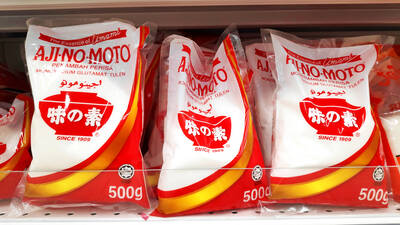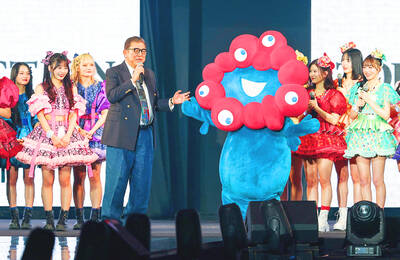Miaoli’s paddy fields, which were once used only for growing rice, have been transformed into canvases for expressing love. Yuanli Farmers Association has been promoting paddy art for the past nine years, and now that they have perfected the art, they are accepting requests for customized paddy “paintings.”
Liang Ruei-hsu, the head of Yuanli Farmers Association’s promotions department, said that most people are curious when they see the dark mauve color of Indica rice plants, so by using these plants along with green plants they can create paddy art and provide employment opportunities for farmers.
Liang says that the association has become very proficient at paddy art and can provide customized creations, whether they are signs, characters, pictures or letters.
In June, one man used paddy art to successfully propose to his girlfriend. Chang Chia-wei, an employee at a paper company, paid NT$30,000 to get the association to write the message “Yen Ju, Follow me OK.” When Liao Yen-ju, his fiancée, saw the rice paddy, she immediately accepted his proposal in front of a cheering crowd of friends.
Paddy art started in 1993, in a village called Inakadate in northern Japan. Although the village has a population of less than 8,500, its paddy art attracts 170,000 tourists per year and brings in a steady stream of income to the local economy. According to news reports, the management office makes NT$1.2 million dollars annually from rent, plan-ting and field maintenance, but visitor donations typically come in at around double that figure.
To create paddy art, the farmers first make a grid on the ground and then create an outline of the pictures or words they want to create, before finally planting the mauve rice plant seeds. Seeds can be planted twice a year, toward the end of February and July.(LIBERTY TIMES, TRANSLATED BY TAIJING WU)
苗栗以往只能種米的稻田,最近搖身一變成為示愛的畫布。苑裡鎮農會推動稻田彩繪邁入第九年,如今稻田彩繪技術成熟,還可接受「客製化」彩繪。
苑裡鎮農會推廣股長梁瑞旭說,一般人對在來米的紫色稻穗感到好奇,所以利用紫色及綠色兩種稻穗,創造稻田彩繪,提供農友就業機會。
梁瑞旭說,苑裡鎮農會的稻田彩繪技術已經純熟,不管是圖騰、文字或圖案、英文字母都可提供「客製化」服務。
六月份就有一位男子,借助彩繪稻田之力,成功地向女朋友求婚。在紙廠上班的張家瑋花了三萬元,委託農會在一幅彩繪稻田上寫著「Yen Ju, Follow me OK」(研如,跟著我好嗎),結果女主角廖研如看到字樣後,在朋友的歡呼下接受求婚。
事實上彩繪稻田藝術於一九九三年,在日本北部的田舍館村誕生。該村人口不到八千五百人,每年卻因此引來十七萬觀光客,各個爭先恐後的想一賭稻田上的圖案,也給當地帶來龐大商機。據報導,田舍館的稻田租金,種植與維護費用每年約台幣一百一十二萬元,但參觀民眾的捐款就多達台幣二百二十四萬元。
如要在稻田上畫出圖案,必須在稻田上以線條畫出格子,然後依照圖樣訂出座標,描出圖樣或字體的輪廓,再種下紫色秧苗。每年的二月底與七月底則為插秧期。
(自由時報記者張勳騰)

The Matsu pilgrimage is one of Taiwan’s most iconic annual religious events. This grand occasion is more than just a religious ceremony; it deeply reflects Taiwan’s history and culture. Originally, Matsu was the goddess of the sea, primarily responsible for protecting fishermen and ensuring their safe voyage. As immigrants brought Matsu worship to Taiwan, she gradually evolved into a deity overseeing health, business, and various aspects of life. In times of uncertainty, Matsu has become a vital source of spiritual comfort for the Taiwanese. The pilgrimage represents Matsu’s annual tour to inspect her domain, driving away evil and bringing

Monosodium glutamate (MSG) has been used in cooking for over a century to enhance flavor. It is often found in Chinese dishes and many other cuisines. Despite its common use, many people misunderstand the safety of MSG. The bad __1__ of MSG started in the late 1960s, when a letter to the New England Journal of Medicine described symptoms like a racing heart, weakness, and numbness after the writer ate Northern Chinese food. While no specific cause was __2__, a series of questionable studies in 1968 began to point the finger at MSG. In one such study, neurologist Herbert Schaumburg and

A: The World Expo 2025 is set to open in Osaka, Japan, on Sunday, with 158 countries and regions and nine international organizations participating in the event. B: Wow, what’s the theme this time? A: The theme is “Designing Future Society for Our Lives.” B: Do you want to go? How long will it last? A: It’ll run for 184 days, until Oct. 13. Maybe we can go to Osaka during summer vacation. A: 2025年世界博覽會預計週日將在日本大阪開幕,158個國家或地區及9大國際組織將參與盛會! B: 哇這次的主題是什麼? A: 主題是:「創造閃耀生命光輝的未來社會」。 B: 你想要去嗎?展出多久啊? A: 世博會共展出184天到10月13日,或許我們暑假時可以去大阪玩。 (By Eddy Chang, Taipei Times/台北時報張迪)

A: The World Expo 2025 is about to open in Osaka. Is Taiwan going to participate in the event too? B: Sure, the Taiwan External Trade Development Council (TAITRA) will launch a Taiwan pavilion named “Tech World.” A: That sounds cool, and it can showcase our national strength in technology. B: The theme is “Connecting the world to create better future lives together.” The pavilion aims to attract over one million visitors. A: I hope humans can really create better future lives through this year’s fair. A: 2025年世博會即將開幕,這次台灣也會參加嗎? B: 當然啦,外貿協會的台灣館將以「Tech World」名義參展! A: 聽起來蠻酷的,應該是想強調台灣的科技實力。 B: 策展主題則是:「連結世界,共創未來美好生活」,希望能吸引到100萬人次參訪。 A: 希望藉由這次世博會,人類真的能共創美好生活。 (By Eddy Chang, Taipei Times/台北時報張迪)